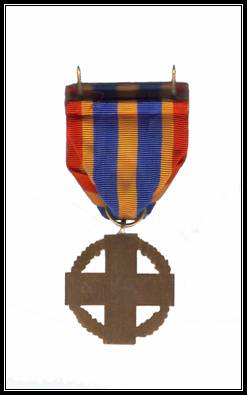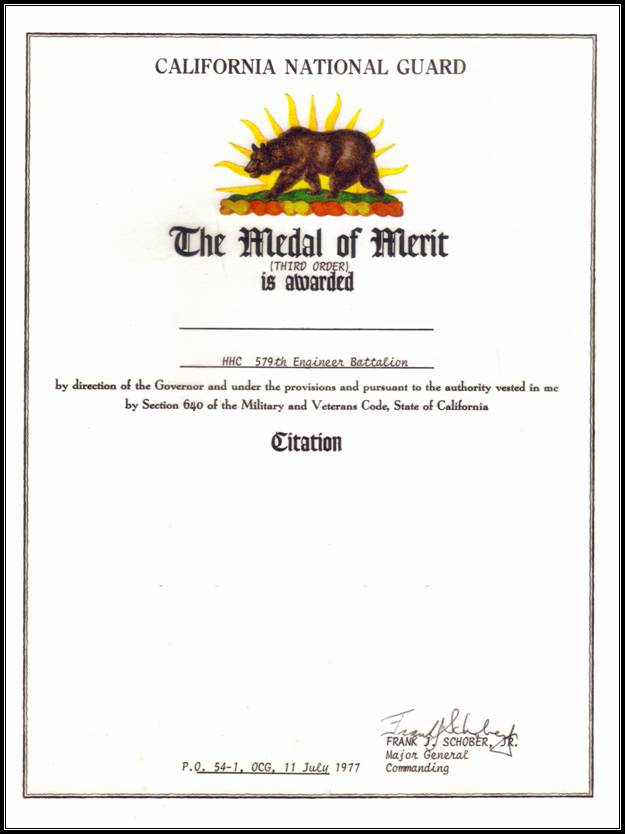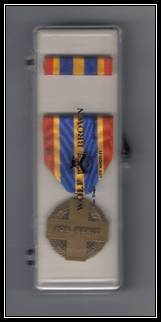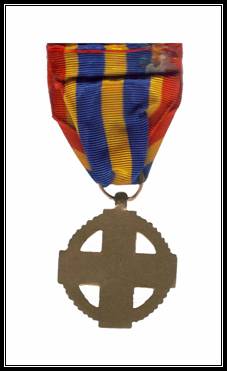%20of%20image001.jpg)
%20of%20image002.jpg)
%20of%20image001.jpg)
%20of%20image002.jpg)
The Medal of Merit (CAMM) is the fourth highest award in the State’s pyramid of honor, and is the second highest award for exceptionally meritorious service.
Criteria for Award: The Medal of Merit is awarded for exceptionally meritorious service to the state or Nation by a member of the California National Guard in a duty of great responsibility; or to any person who, by unselfish and untiring activities in connection with the National guard, has rendered a distinct service in furthering the interest of and in promoting the security and welfare of the state. The Medal of Merit may also be awarded to civilians and members of other military services who distinguish themselves as indicated above.
History: This was the third decoration authorized by the state legislature on 16 June 1933. The Medal of Merit was addressed in Chapter 975, Sections 381 and 382 of the Military Code. Current statutory authority is found in Section 643 Military Veterans Code.
This medal is thought to have been issued no later than February 1948. The original Type 1 medal (see Figure 1) had a three ring suspension (one ring parallel to, and part of the medal) similar to the California Service Medal (Type 2 Variety 1) medal also issued at this time. These medals were pin backed medals produced by Wolfe Brown of Los Angeles, Ca.
From about the early 1960’s to the late 1970’s a Type 2 medal (solid planchet) was awarded (see Figure 2). It is believed this may have been an attempt to reduce the cost of the medals themselves. The Type 3 medal (see Figure 3) had the metal between the arms of the cross and the redwood wreaths removed as in the Type 1 medal, resulting in a more attractive appearing medal. The Type 3 medal was produced by Wolfe Brown until Vanguard bought out Wolfe Brown in Feb 1985. Other than some minor die differences in the lettering of “For Merit” on the face of the cross, the Type 3 medals continued pretty much unchanged up until the early 2000’s, when a Type 4 medal (see Figure 8) started being award, produced by Graco Inc. of Tomball, TX. This change was again caused by a desire for cost reduction, and sadly a corresponding reduction in quality and appearance took place. The history of the award between 1953 and 1976 consists primary of records of the quantity awarded. Through the end of 1968, a total of 426 crosses were awarded and 56 gold oak leaf clusters were attached to these (second awards). Award documents were awarded with these awards (See Figures 5 and 6). Originally a gold oak leaf was used to denote subsequent awards. Such awards are now denoted with a bronze oak leaf for a second award, and a silver oak leaf for 5 awards.
%20of%20image003.jpg)
%20of%20image004.jpg)
From 2 August 1976 to 1 November 1977, this medal was awarded in three degrees (Orders). These Orders (1st the highest) were designated by attachment of a service star 3/16th inch in size of differing metals to the ribbon of the medal. The stars were gold for 1st Order, silver for second Order, and bronze for third Order (See Figures 4, and 5). The third order replaced the Commendation Medal which was not awarded during this time. The various Orders were awarded for a little more than a year, although awards made during that period may still be worn. From a collector’s stand point the Orders are exceptionally rare.
%20of%20image005.jpg)

%20of%20image007.jpg)

%20of%20image009.jpg)

%20of%20image011.jpg)

I am indebted to Captain Gregory Ogletree for his kind permission to use much of the data contained in this article, which came from his book: Awards and Decorations of U. S. State Military Forces, 1988. Patriot Press. I am also indebted to S. G. (Yash) Yasinitsky, OMSA#1 for his support, information, and friendship over the years.
Written 30 April 2008, Posted 25 January 2009